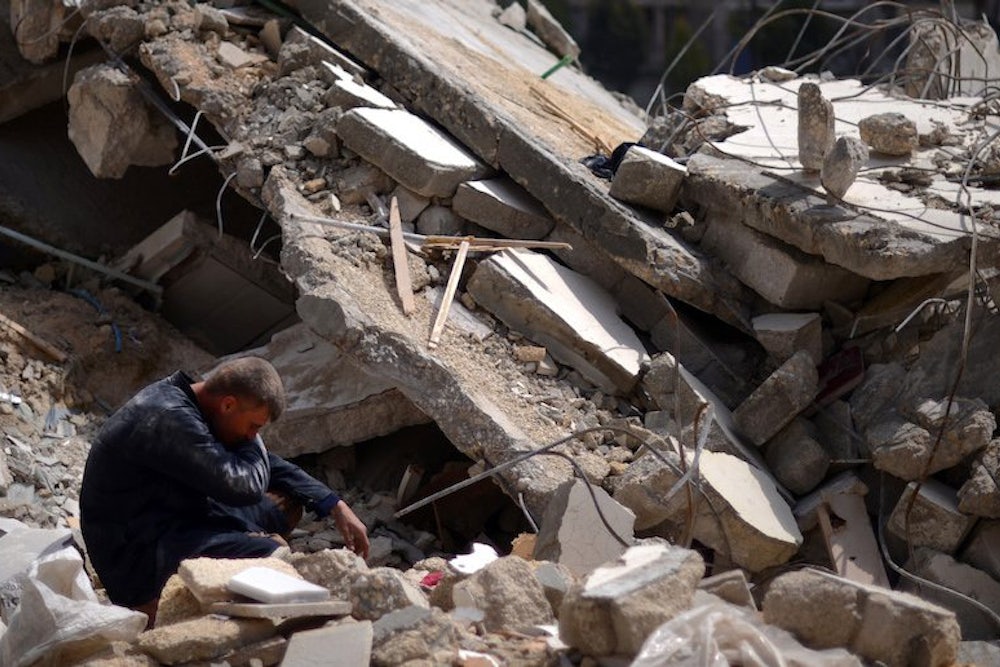A few days ago, as the number of refugees streaming out of Aleppo, Syria’s largest city, began to escalate dramatically, I phoned an aid worker friend of mine who knows the city intimately.
He was traveling in southern Turkey at the time, but when I got him on the line, he sounded frantic. "The bombing is unprecedented today," he said. (I promised not to identify him because he hopes to continue working inside Syria as soon as conditions allow it.) “In the past few weeks they have dropped so much fucking hardware on everything. Every part of Aleppo—marketplaces, vegetable stands, anywhere there's a big collection of civilians. It’s incredible."
The regime bombardment of the rebel-held, eastern part of Aleppo—much of it in the form of indiscriminate “barrel bombs,” which are little more than metal cylinders filled with explosives and rebar—has been ongoing for more than a month. But more recently, the aid worker and several exiles from the city told me, the cascade had grown much more intense, driving out even the most hardened holdouts. Upwards of a quarter-million people have fled the east for safe havens to the north or, in some cases, across town into regime-controlled quarters, according to official estimates. All of the infrastructure of rebel-controlled Syria has shut down: the local councils, which help run city administration; the various relief agencies; even the bakeries that, with international assistance, produce bread for the starving population. Almost no one has been left behind in some parts. “There’s been areas that are just completely emptied out—not a living soul,” the aid worker said. “It’s obvious that they're hoping to drive everyone out.”
What’s disturbing about the current round of bombings and evacuations is not simply that it’s a humanitarian disaster, but that it seems to fit a pattern of the Syrian government’s campaign to retake rebel-held parts of the north: destroy a city, empty it out. In November, the Syrian army recaptured the town of Safira, just outside of Aleppo, after a bombing campaign that lasted a month and reportedly forced the entire population to evacuate. When a neighborhood of Hama, another city in the north that has figured prominently in the revolution, appeared to harbor rebel fighters, the regime simply had it leveled — every single building. And before this week’s deliveries of food aid to besieged populations in rebel-controlled Homs, the regime argued vociferously that residents should be evacuated, rather than have food brought in to them.
It’s possible, of course, that this population exodus is simply the byproduct of a brutal, scorched-earth military campaign. But the widespread utilization of the tactic, and the fact that it disproportionately results in the dispersal of Sunni Muslim backers of the uprising, raises questions about the government’s ultimate goal. Two weeks ago, Human Rights Watch published a report that studied the razing of thousands of residential buildings in Damascus and Hama over the past year and a half, and concluded that these efforts "served no necessary military purpose.”
For years, analysts have warned about the possibility that Syria’s conflict could result in the fracturing of the country along sectarian lines, and the creation of ethnically distinct enclaves—or, worse, bouts of ethnic cleansing. When the opposition forces were thriving, most of that talk focused on the possibility that aggrieved Sunni Islamists in the rebellion might seek to purge the country of pro-regime minorities, like Christians and Alawites—the Shiite sect that counts Bashar al Assad as a member. (There have already been reports of retributive massacres of Alawite communities, by Sunni militants.) Now, as the regime's forces regain momentum, it seems possible that Sunni civilians could find themselves on the receiving end of a similar effort. "Even if it's not ethnic cleansing in its purest form—because there's no articulated plan to get rid of all Sunni Arabs from Syria, and that would be impossible anyway—it sure smells of it," said Joshua Landis, an expert on Syria at the University of Oklahoma. Landis has argued that the Syrian war could result in a broader, regional ethnic “rearrangement.”
Whatever the ultimate scheme behind the latest aerial campaign, it’s evident that the attacks have pushed Sunni opposition supporters out of the rebel side of Aleppo in previously unseen numbers. A western official in Turkey told me that it was the largest movement of population since the war began. Over the weekend, I traveled to a border crossing near Aleppo and spoke with families as they entered Turkey. The trip north from Aleppo to the border, normally just a forty-five minute drive, had taken five or six hours, they said. On the Syrian side, tens of thousands of people were backed up, waiting for the anxious Turkish border guards to let them trickle in. (Turkey already hosts more than a half million Syrian refugees, and officials say that they are both at maximum capacity, and worried about the possibility of terrorists mixing in with new entrants.)
One by one, the evacuees, their life’s belongings amassed at their feet, described how the city had suddenly become uninhabitable. "In the last week, it just got so much worse,” one of the former residents, who said he hadn’t previously left town since the start of the war, told me. "They're sending out a clear message that they want the city empty."
